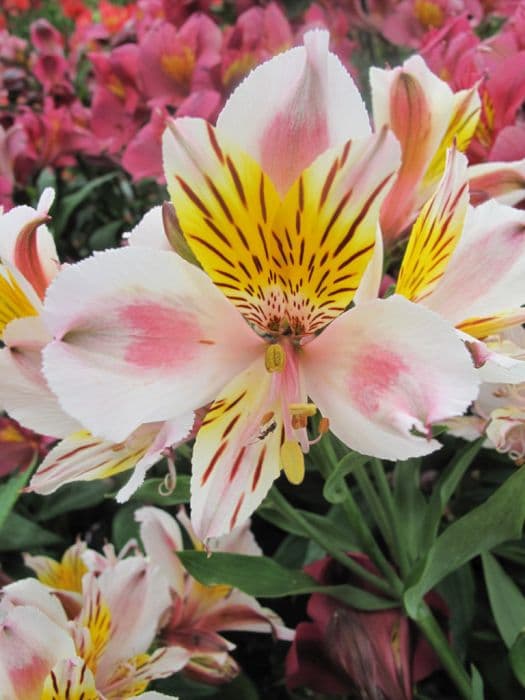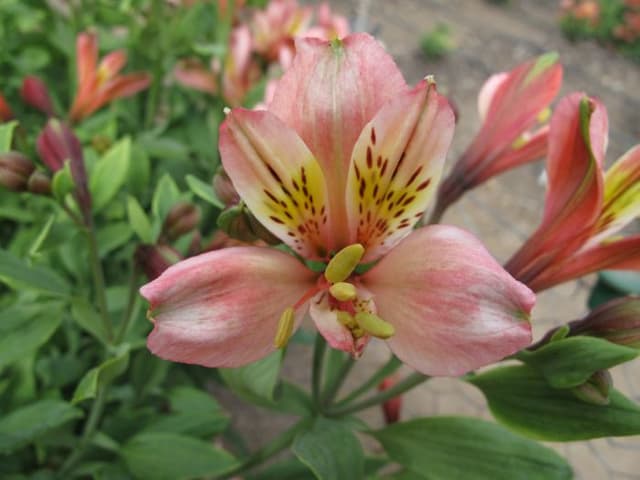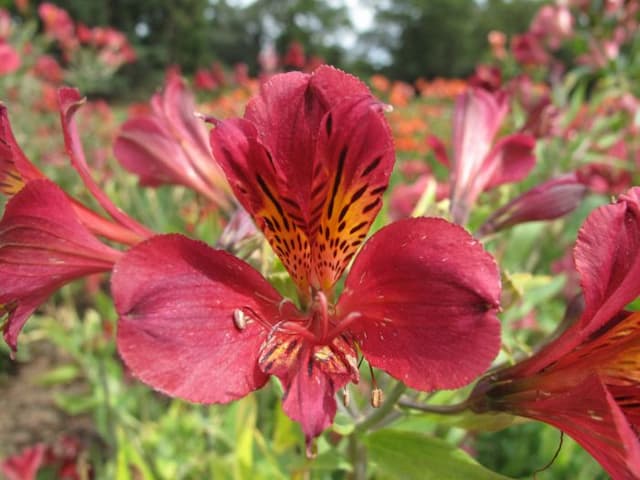Alstroemeria Inticancha Passion = 'Tespassion' (PBR) (Inticancha Series)
![Peruvian lily [Inticancha Passion]](/_next/image?url=https%3A%2F%2Fplants-admin.emdemapps.com%2Fimages%2Fplants%2F%2Fimages%2F604b5f7a78c8d.png&w=3840&q=75)
ABOUT
Alstroemeria Inticancha Passion, commonly known as Peruvian Lily or Lily of the Incas, is a stunningly colorful perennial that adds splashes of vibrant hues to any garden. The appearance of this variety is characterized by its striking, funnel-shaped flowers, which come in an eye-catching blend of pink and burgundy hues. The petals are adorned with dark flecks and streaks, creating a dramatic, exotic look. The blooms are clustered at the top of tall, slender stems that rise up from a dense clump of narrow, lance-shaped leaves. The leaves are a rich green color and have a slightly twisted or spiral form, giving the plant an added sense of texture and depth. The Peruvian Lily's flowers not only offer beauty but also have the remarkable ability to last for an extended period when cut, making them a favorite choice for floral arrangements and bouquets. The Inticancha Passion's showy flowers, combined with its lush foliage, make it a popular choice for gardeners looking to inject a pop of color into their landscape. Its bloom time extends from early summer to fall, ensuring a long-lasting display of its magnificent flowers.
About this plant
 Names
NamesFamily
Alstroemeriaceae
Synonyms
Peruvian Lily, Lily of the Incas, Parrot Lily
Common names
Alstroemeria Inticancha Passion = 'Tespassion' (PBR) (Inticancha Series)
 Toxicity
ToxicityTo humans
The Alstroemeria, commonly known as Peruvian Lily or Lily of the Incas, has a low degree of toxicity to humans. It is not generally considered to be poisonous, but it can cause mild irritation. If ingested, parts of the plant may cause stomach upset or vomiting. Handling the plant may sometimes result in skin irritation due to the sap. Therefore, it is advisable to wash hands after handling the Alstroemeria and to keep the plant out of reach of small children who may accidentally ingest parts of it.
To pets
The Alstroemeria, commonly referred to as Peruvian Lily or Lily of the Incas, is considered mildly toxic to pets, such as cats and dogs. If pets ingest parts of the plant, they might experience symptoms such as vomiting, diarrhea, and drooling. In rare cases, ingestion can result in mild dermatitis or an allergic reaction. It is advisable to prevent pets from accessing this plant and to seek veterinary care if you suspect your pet has ingested any part of this Alstroemeria.
 Characteristics
CharacteristicsLife cycle
Perennials
Foliage type
Evergreen
Color of leaves
Green
Flower color
Pink
Height
1-2 feet (30-60 cm)
Spread
1-2 feet (30-60 cm)
Plant type
Herb
Hardiness zones
7
Native area
South America
Benefits
 General Benefits
General Benefits- Long Blooming Period: Produces a profusion of blooms from early summer to fall, providing lasting color in the garden.
- Attracts Pollinators: Draws in bees, butterflies, and other beneficial insects, contributing to pollination in the garden.
- Low Maintenance: Requires minimal care once established, making it an ideal choice for busy gardeners.
- Drought Tolerance: Once established, it has a degree of drought tolerance, reducing the need for frequent watering.
- Versatile Usage: Suitable for containers, borders, and as a cut flower, offering various uses in landscaping and floral arrangements.
- Compact Growth: The Inticancha series, including Tespassion, is known for its compact, upright form, ideal for small gardens and spaces.
- Cold Hardy: It can withstand cooler temperatures, which makes it suitable for a range of climates.
 Medical Properties
Medical PropertiesThis plant is not used for medical purposes.
 Air-purifying Qualities
Air-purifying QualitiesThis plant is not specifically known for air purifying qualities.
 Other Uses
Other Uses- Photography Prop: The vibrant blossoms of the Peruvian Lily make it a popular choice for photographers seeking to add a splash of color to their floral photo shoots.
- Artistic Inspiration: Artists may use the Peruvian Lily as a subject for paintings, drawings, or other artistic endeavors due to its intricate patterns and array of colors.
- Edible Decoration: While not commonly known for edibility, the flowers could potentially be used as a decorative, non-toxic garnish for plates and desserts in high-end culinary presentations, after ensuring they are safe to be in contact with food.
- Teaching Tool: Botany educators could use the Peruvian Lily to teach students about plant reproduction and hybridization in the Inticancha series, as it is a result of careful breeding.
- Crafting: The sturdy stems and long-lasting blooms make the Peruvian Lily an excellent addition to homemade wreaths or other craft projects where fresh flowers could be utilized.
- Color Therapy: The vivid colors of Peruvian Lily might be employed by therapists for color therapy sessions to promote emotional well-being through visual stimulation.
- Fragrance Extraction: Although not common, the subtle scent of the Peruvian Lily could be captured and used in homemade potpourris or natural fragrance sachets.
- Fashion Accessory: The flowers could be used to create unique, temporary botanical jewelry, such as a necklace or a bracelet, for special events.
- Handwriting Practice: The long, straight stems of the Peruvian Lily could serve as natural guides for children learning to write or for calligraphy practice to maintain straight lines.
- Biodegradable Confetti: Dried petals of the Peruvian Lily, if they retain color, could be used as biodegradable confetti for eco-friendly celebrations.
Interesting Facts
 Feng Shui
Feng ShuiThe Peruvian Lily is not used in Feng Shui practice.
 Zodiac Sign Compitability
Zodiac Sign CompitabilityThe Peruvian Lily is not used in astrology practice.
 Plant Symbolism
Plant Symbolism- Friendship and Devotion: Alstroemeria, commonly known as Peruvian Lily or Lily of the Incas, often symbolizes enduring friendship and devotion with its twisted leaves that are said to represent the ups and downs of friendships.
- Wealth, Prosperity and Fortune: The bouquet of Alstroemeria is sometimes given to wish someone wealth, prosperity, and fortune, reflecting the belief that these flowers bring good luck and positive energy to a person's life.
- Strength and Personal Growth: Peruvian Lilies are associated with strength and personal growth because of their resilience and ability to adapt to different environments, encouraging individuals to persevere through challenges.
- Mutual Support: Reflecting the supporting structure of its interlaced leaves, Alstroemeria symbolizes the idea of mutual support in relationships, highlighting the importance of working together and supporting one another.
 Water
WaterPeruvian Lilies require regular watering, especially during the growing season, to keep the soil consistently moist but not waterlogged. Water them thoroughly until water starts to drain from the bottom of the pot, approximately once a week, depending on the temperature and humidity. In hotter periods, they may need watering twice a week. During winter, reduce watering to prevent the soil from becoming too wet, which could lead to root rot. Typically, you should aim to give your plants about 1 gallon of water every 7-10 days, adjusting for weather conditions and soil moisture levels.
 Light
LightPeruvian Lilies thrive best in bright, indirect sunlight. They can tolerate some direct morning light but should be protected from hot afternoon sun, which can scorch their leaves. A spot near a south or west-facing window with some light shading is ideal. Ensure the plant receives at least 6 hours of light per day for optimum growth.
 Temperature
TemperaturePeruvian Lilies perform best in temperatures ranging from 65 to 80 degrees Fahrenheit. They can tolerate minimum temperatures down to approximately 40 degrees Fahrenheit at night and a maximum of about 90 degrees Fahrenheit during the day. However, extreme temperatures should be avoided to prevent stress and damage to the plant.
 Pruning
PruningPruning Peruvian Lilies is essential to remove spent flowers and encourage further blooming. Deadhead the flowers as they fade and cut back stems that have finished flowering. Pruning can be done throughout the blooming season. The best time for major pruning is late winter or early spring, just before new growth begins.
 Cleaning
CleaningAs needed
 Soil
SoilThe best soil mix for the Peruvian Lily (Alstroemeria 'Inticancha Passion') should be well-draining, rich in organic matter, and have a slightly acidic to neutral pH of 6.0 to 7.0. A blend of two parts peat or coconut coir, one part perlite or pumice, and one part compost or aged manure is recommended.
 Repotting
RepottingPeruvian Lilies (Alstroemeria 'Inticancha Passion') generally require repotting every two to three years or when they outgrow their containers. It's best to repot them in the spring before the growing season begins.
 Humidity & Misting
Humidity & MistingPeruvian Lilies (Alstroemeria 'Inticancha Passion') thrive at moderate humidity levels, ideally between 40-60%. Avoid environments that are too dry or excessively humid to maintain the plant's health.
 Suitable locations
Suitable locationsIndoor
Place in bright, indirect light. Keep soil moist, not soggy.
Outdoor
Plant in partial shade. Protect from afternoon sun.
Hardiness zone
7-10 USDA
 Life cycle
Life cycleAlstroemeria 'Inticancha Passion', also known as Peruvian Lily or Lily of the Incas, begins its life cycle as a thickened rhizome, which undergoes a period of dormancy before sprouting. After breaking dormancy, the rhizomes send up shoots which develop into stems with lance-shaped leaves. As the plant matures, clusters of funnel-shaped flowers with unique patterns and striking colors bloom throughout the summer months. After the flowering period, the plant sets seeds which can be dispersed to produce new plants, although commercial propagation is more commonly done vegetatively. Once the growing season concludes, the above-ground foliage dies back, with the plant re-entering a state of dormancy during the colder months, conserving energy in its rhizomes. This cycle repeats year after year, with Alstroemeria 'Inticancha Passion' capable of surviving mild winters and reemerging in the spring.
 Propogation
PropogationPropogation time
Spring to Summer
Alstroemeria Inticancha Passion, also known as Peruvian Lily, is mostly propagated through division, a process best performed in late winter or early spring before the plant begins its active growth. To propagate by division, carefully dig up the clump of tubers and gently separate or cut them apart, ensuring that each section has at least one eye or shoot. Replant the divisions at the same depth they were growing before, which is typically about 6 to 8 inches (15 to 20 centimeters) deep, allowing room for root development. Water the new plantings thoroughly to settle the soil around the roots and initiate growth. This method is the most popular because it maintains the true-to-type characteristics of the ‘Tespassion’ cultivar and usually results in more vigorous plants than those started from seed.



![Peruvian lily [Inca Glow]](/_next/image?url=https%3A%2F%2Fplants-admin.emdemapps.com%2Fimages%2Fplants%2F%2Fimages%2F604b5e99e48d9.png&w=640&q=75)
![Peruvian lily [Inca Smile]](/_next/image?url=https%3A%2F%2Fplants-admin.emdemapps.com%2Fimages%2Fplants%2F%2Fimages%2F604b5cad8fa91.png&w=640&q=75)


![Peruvian lily [Summer Breeze]](/_next/image?url=https%3A%2F%2Fplants-admin.emdemapps.com%2Fimages%2Fplants%2F%2Fimages%2F604b6401573b7.png&w=640&q=75)

